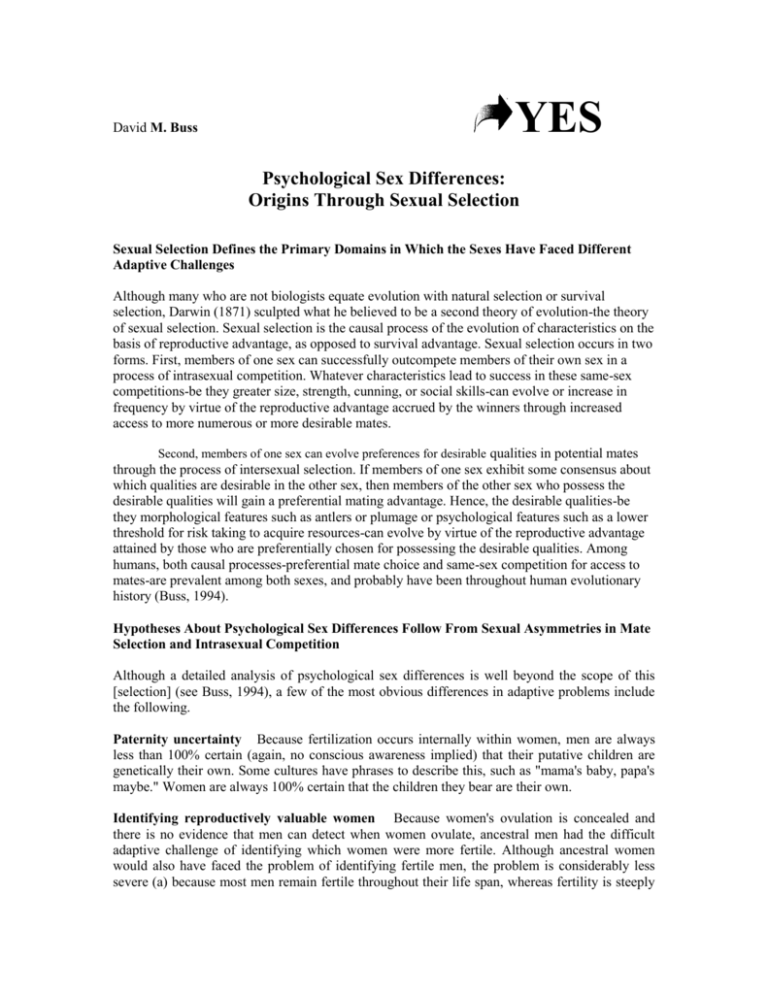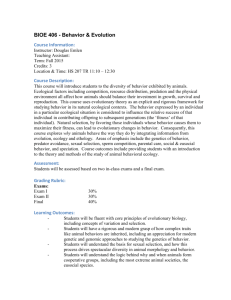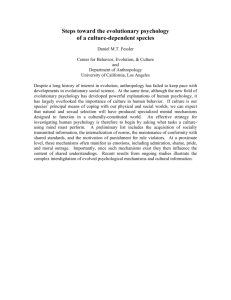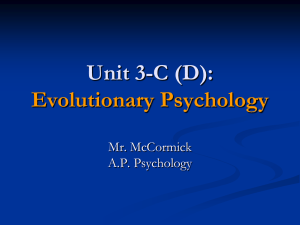
David M. Buss
YES
Psychological Sex Differences:
Origins Through Sexual Selection
Sexual Selection Defines the Primary Domains in Which the Sexes Have Faced Different
Adaptive Challenges
Although many who are not biologists equate evolution with natural selection or survival
selection, Darwin (1871) sculpted what he believed to be a second theory of evolution-the theory
of sexual selection. Sexual selection is the causal process of the evolution of characteristics on the
basis of reproductive advantage, as opposed to survival advantage. Sexual selection occurs in two
forms. First, members of one sex can successfully outcompete members of their own sex in a
process of intrasexual competition. Whatever characteristics lead to success in these same-sex
competitions-be they greater size, strength, cunning, or social skills-can evolve or increase in
frequency by virtue of the reproductive advantage accrued by the winners through increased
access to more numerous or more desirable mates.
Second, members of one sex can evolve preferences for desirable qualities in potential mates
through the process of intersexual selection. If members of one sex exhibit some consensus about
which qualities are desirable in the other sex, then members of the other sex who possess the
desirable qualities will gain a preferential mating advantage. Hence, the desirable qualities-be
they morphological features such as antlers or plumage or psychological features such as a lower
threshold for risk taking to acquire resources-can evolve by virtue of the reproductive advantage
attained by those who are preferentially chosen for possessing the desirable qualities. Among
humans, both causal processes-preferential mate choice and same-sex competition for access to
mates-are prevalent among both sexes, and probably have been throughout human evolutionary
history (Buss, 1994).
Hypotheses About Psychological Sex Differences Follow From Sexual Asymmetries in Mate
Selection and Intrasexual Competition
Although a detailed analysis of psychological sex differences is well beyond the scope of this
[selection] (see Buss, 1994), a few of the most obvious differences in adaptive problems include
the following.
Paternity uncertainty Because fertilization occurs internally within women, men are always
less than 100% certain (again, no conscious awareness implied) that their putative children are
genetically their own. Some cultures have phrases to describe this, such as "mama's baby, papa's
maybe." Women are always 100% certain that the children they bear are their own.
Identifying reproductively valuable women Because women's ovulation is concealed and
there is no evidence that men can detect when women ovulate, ancestral men had the difficult
adaptive challenge of identifying which women were more fertile. Although ancestral women
would also have faced the problem of identifying fertile men, the problem is considerably less
severe (a) because most men remain fertile throughout their life span, whereas fertility is steeply
age graded among women and (b) because women invest more heavily in offspring, making them
the more "valuable" sex, competed for more intensely by men seeking sexual access. Thus, there
is rarely a shortage of men willing to contribute the sperm necessary for fertilization, whereas
from a man's perspective, there is a pervasive shortage of fertile women.
Gaining sexual access to women Because of the large asymmetry between men and women in
their minimum obligatory parental investment-nine months gestation for women versus an act of
sex for men-the direct reproductive benefits of gaining sexual access to a variety of mates would
have been much higher for men than for women throughout human evolutionary history (Symons,
1979; Trivers, 1972). Therefore, in social contexts in which some short-term mating or
polygynous mating were possible, men who succeeded in gaining sexual access to a variety of
women, other things being equal, would have experienced greater reproductive success than men
who failed to gain such access (see also Greiling, 1993, for adaptive benefits to women of shortterm mating).
Identifying men who are able to invest Because of the tremendous burdens of a nine-month
pregnancy and subsequent lactation, women who selected men who were able to invest resources
in them and their offspring would have been at a tremendous advantage in survival and
reproductive currencies compared with women who were indifferent to the investment
capabilities of the man with whom they chose to mate.
Identifying men who are willing to invest Having resources is not enough. Copulating with a
man who had resources but who displayed a hasty postcopulatory departure would have been
detrimental to the woman, particularly if she became pregnant and faced raising a child without
the aid and protection of an investing father. A man with excellent resource-accruing capacities
might channel resources to another woman or pursue short-term sexual opportunities with a variety of women. A woman who had the ability to detect a man's willingness to invest in her and
her children would have an adaptive advantage compared with women who were oblivious to a
man's willingness or unwillingness to invest.
These are just a few of the adaptive problems that women and men have confronted differently or
to differing degrees. Other examples of sex-linked adaptive problems include those of coalitional
warfare, coalitional defense, hunting, gathering, combating sex-linked forms of reputational
damage, embodying sex-linked prestige criteria, and attracting mates by fulfilling the differing
desires of the other sex-domains that all have consequences for mating but are sufficiently wideranging to span a great deal of social psychology (Buss, 1994). It is in these domains that
evolutionary psychologists anticipate the most pronounced sex differences-differences in
solutions to sex-linked adaptive problems in the form of evolved psychological mechanisms.
Psychological Sex Differences Are Well Documented Empirically in the Domains Predicted
by Theories Anchored in Sexual Selection
When Maccoby and Jacklin (1974) published their classic book on the psychology of sex
differences, knowledge was spotty and methods for summarizing the literature were largely
subjective and interpretive. Since that time, there has been a veritable explosion of empirical
findings, along with quantitative meta-analytic procedures for evaluating them (e.g., Eagly, 1995;
Feingold, 1990; Hall, 1978; Hyde, in press; Oliver & Hyde, 1993; Rosenthal, 1991). Although
new domains of sex differences continue to surface, such as the recently documented female
advantage in spatial location memory (Silverman & Eals, 1992), the outlines of where researchers
find large, medium, small, and no sex differences are starting to emerge more clearly.
A few selected findings illustrate the heuristic power of evolutionary psychology. Cohen
(1977) used the widely adopted d statistic as the index of magnitude of effect to propose a rule of
thumb for evaluating effect sizes: 0.20 = "small," 0.50 = "medium," and 0.80 = "large." As Hyde
(in press) has pointed out in a chapter titled "Where Are the Gender Differences? Where Are the
Gender Similarities?," sex differences in the intellectual and cognitive ability domains tend to be
small. Women's verbal skills tend to be slightly higher than men's (d=- 0.11). Sex differences in
math also tend to be small (d = 0.15). Most tests of general cognitive ability, in short, reveal small
sex differences.
The primary exception to the general trend of small sex differences in the cognitive abilities
domain occurs with spatial rotation. This ability is essential for successful hunting, in which the
trajectory and velocity of a spear must anticipate correctly the trajectory of an animal as each
moves with different speeds through space and time. For spatial rotation ability, d = 0.73. Other
sorts of skills involved in hunting also show large magnitudes of sex differences, such as
throwing velocity (d = 2.18), throwing distance (d = 1.98), and throwing accuracy (d = 0.96;
Ashmore, 1990). Skilled hunters, as good providers, are known to be sexually attractive to
women in current and traditional tribal societies (Hill & Hurtado, 1989; Symons, 1979).
Large sex differences appear reliably for precisely the aspects of sexuality and mating
predicted by evolutionary theories of sexual strategies (Buss & Schmitt, 1993). Oliver and Hyde
(1993), for example, documented a large sex difference in attitudes toward casual sex (d = 0.81).
Similar sex differences have been found with other measures of men's desire for casual sex
partners, a psychological solution to the problem of seeking sexual access to a variety of partners
(Buss & Schmitt, 1993; Symons, 1979). For example, men state that they would ideally like to
have more than 18 sex partners in their lifetimes, whereas women state that they would desire
only 4 or 5 (d = 0.87; Buss & Schmitt, 1993). In another study that has been replicated twice,
75% of the men but 0% of the women approached by an attractive stranger of the opposite sex
consented to a request for sex (Clark & Hatfield, 1989).
Women tend to be more exacting than men, as predicted, in their standards for a short-term
mate (d = 0.79). Women tend to place greater value on good financial prospects in a mate-a
finding confirmed in a study of 10,047 individuals residing in 37 cultures located on six
continents and five islands from around the world (Buss, 1989a). More so than men, women
especially disdain qualities in a potential mate that signal inability to accrue resources, such as
lack of ambition (d = 1.38) and lack of education (d = 1.06). Women desire physical protection
abilities more than men, both in short-term mating (d = 0.94) and in long-term mating (d = 0.66).
Men and women also differ in the weighting given to cues that trigger sexual jealousy. Buss,
Larsen, Westen, and Semmelroth (1992) presented men and women with the following dilemma:
"What would upset or distress you more: (a) imagining your partner forming a deep emotional
attachment to someone else or (b) imagining your partner enjoying passionate sexual intercourse
with that other person" (p. 252). Men expressed greater distress about sexual than emotional
infidelity, whereas women showed the opposite pattern. The difference between the sexes in
which scenario was more distressing was 43% (d = 0.98). These sex differences have been
replicated by different investigators (Wiederman & Allgeier, 1993) with physiological recording
devices (Buss et al., 1992) and have been replicated in other cultures (Buunk, Angleitner, Oubaid,
& Buss, 1994).
These sex differences are precisely those predicted by evolutionary psychological theories
based on sexual selection. They represent only a sampling from a larger body of supporting
evidence. The sexes also differ substantially in a wide variety of other ways that are predicted by
sexual selection theory, such as in thresholds for physical risk taking (Wilson & Daly, 1985), in
frequency of perpetrating homicides (Daly & Wilson, 1988), in thresholds for inferring sexual
intent in others (Abby, 1982), in perceptions of the magnitude of upset people experience as the
victims of sexual aggression (Buss, 1989b), and in the frequency of committing violent crimes of
all sorts (Daly & Wilson, 1988). As noted by Donald Brown (1991), "it will be irresponsible to
continue shunting these [findings] aside, fraud to deny that they exist" (p. 156). Evolutionary psychology sheds light on why these differences exist.
Conclusions
Strong sex differences occur reliably in domains closely linked with sex and mating, precisely as
predicted by psychological theories based on sexual selection (Buss, 1994). Within these
domains, the psychological sex differences are patterned in a manner that maps precisely onto the
adaptive problems men and women have faced over human evolutionary history. Indeed, in most
cases, the evolutionary hypotheses about sex differences were generated a decade or more before
the empirical tests of them were conducted and the sex differences discovered. These models thus
have heuristic and predictive power.
The evolutionary psychology perspective also offers several insights into the broader
discourse on sex differences. First, neither women nor men can be considered "superior" or
"inferior" to the other, any more than a bird's wings can be considered superior or inferior to a
fish's fins or a kangaroo's legs. Each sex possesses mechanisms designed to deal with its own
adaptive challenges - some similar and some different - and so notions of superiority or inferiority
are logically incoherent from the vantage point of evolutionary psychology. The meta-theory of
evolutionary psychology is descriptive, not prescriptive-it carries no values in its teeth.
Second, contrary to common misconceptions about evolutionary psychology, finding that
sex differences originated through a causal process of sexual selection does not imply that the
differences are unchangeable or intractable. On the contrary, understanding their origins provides
a powerful heuristic to the contexts in which the sex differences are most likely to be manifested
(e.g., in the context of mate competition) and hence provides a guide to effective loci for
intervention if change is judged to be desirable.
Third, although some worry that inquiries into the existence and evolutionary origins of sex
differences will lead to justification for the status quo, it is hard to believe that attempts to change
the status quo can be very effective if. they are undertaken in ignorance of sex differences that
actually exist. Knowledge is power, and attempts to intervene in the absence of knowledge may
resemble a surgeon operating blindfolded-there may be more bloodshed than healing (Tooby &
Cosmides, 1992).
The perspective of evolutionary psychology jettisons the outmoded dualistic thinking
inherent in much current discourse by getting rid of the false dichotomy between biological and
social. It offers a truly interactionist position that specifies the particular features of social context
that are especially critical for processing by our evolved psychological mechanisms. No other
theory of sex differences has been capable of predicting and explaining the large number of
precise, detailed, patterned sex differences discovered by research guided by evolutionary
psychology (e.g., Bailey, Gaulin, Agyei, & Gladue, 1994; Buss & Schmitt, 1993; Daly & Wilson,
1988; Ellis & Symons, 1990; Gangestad & Simpson, 1990; Greer & Buss, 1994; Kenrick &
Keefe, 1992; Symons, 1979). Evolutionary psychology possesses the heuristic power to guide
investigators to the particular domains in which the most pronounced sex differences, as well as
similarities, will be found. People grappling with the existence and implications of psychological
sex differences cannot afford to ignore their most likely evolutionary origins through sexual
selection.









